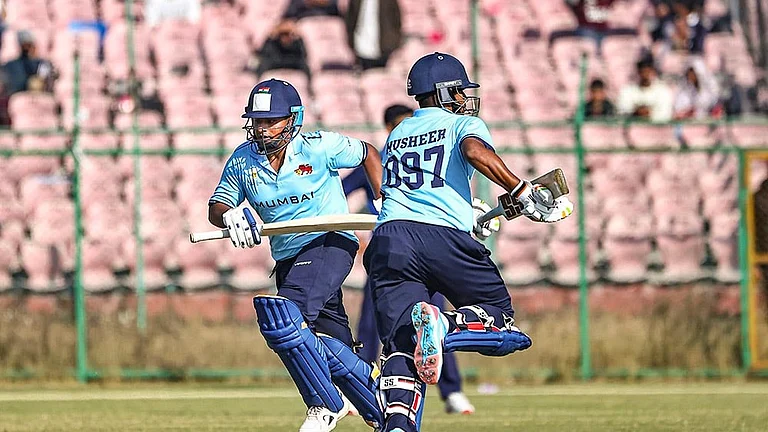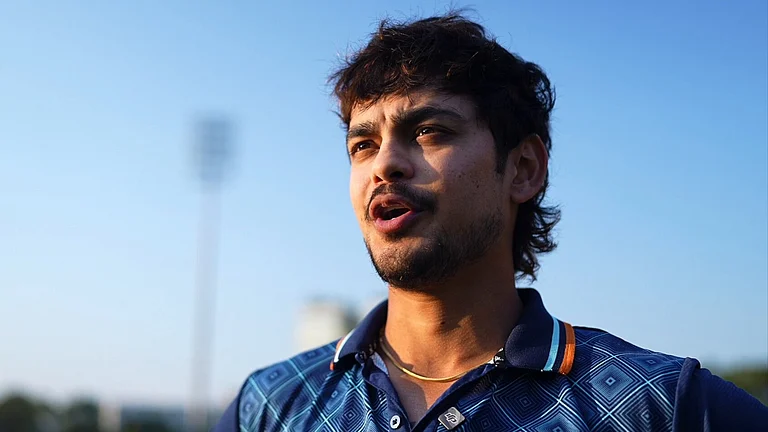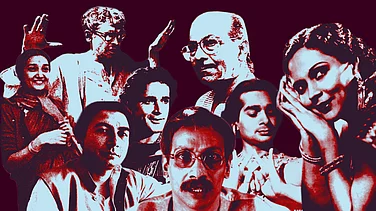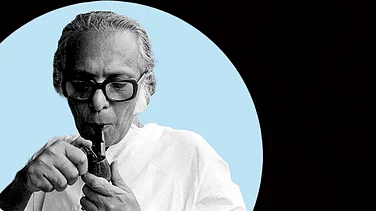Love thrives on the myth of neverendingness. Never-ending companionship—till death do us part. Or the never-ending wait for the Beloved. For lavani singers and dancers however, love is fleeting. “We have mastered the art of enticement. But we can rarely hold on to love,” Vaishali Nagarkar jokes.
A veteran on stage, Nagarkar, 47, belongs to the Kolhati community, a nomadic tribe that once travelled from village to village on bullock carts, performing Tamasha. Today, a majority of the women from the community make a living by performing lavani, an ‘erotic’ dance historically performed by Dalit—and later tribal—women for exclusively male audiences in parts of Maharashtra. Nagarkar herself has been dancing lavani for 30 years, an art she inherited from her mother.
“Most children born to lavani dancers have no fathers and are born out of wedlock. Once a lavani dancer puts on the ghungroos (anklets), she cannot marry anymore,” says Nagarkar. And yet lavani dancers keep falling in love and believing in the fickle promises of ‘powerful men’: ‘men of means’ who watch them dance, objectify them, fall in love with them and then leave them.
Distinct from other dance forms that have been Brahminised and brought within the pantheon of Indian performative arts, lavani has remained marginalised despite a history of several centuries, and is primarily performed, at least in its living, organic form today, in small towns and rural spaces.
In the 21st century, lavani exists simultaneously across multiple universes. There is the ‘folkised’, ‘respectable’ lavani that receives state and artistic patronage today. Then there is the lavani that has been popularised by countless Bollywood song and dance sequences. (Helen from Mungda Mungda comes to mind). And then, there is the lavani of the masses. This is the version that has been performed organically over the years, mainly by women belonging to oppressed communities, for both Brahminical and non-Brahminical audiences, in urban theatre spaces and sangeet baris, mainly in the Pune area, where artists like Nagarkar perform.

Life in a sangeet bari
Sangeet bari performances are closed-door acts that take place every evening in venues where the troops live. Sangeet baris and the idea of public theatres grew in the 1880s following the imperial industrial boom in Maharashtra and the emergence of a new middle-class theatregoer who sought cheap public entertainment. These are rowdy spaces that high-brow visitors often describe as ‘vulgar’ and ‘brothel-like’.
In a typical sangeet bari performance today, the dancers first perform for the general audience from about 6.30 to 9.30 p.m. The setting is crude and the audience rustic and mostly male. Wolf whistles, catcalls and the showering of currency notes are a frequent sight. After that, the private baithak starts for select connoisseurs and regulars.
Padmashree winner Sudharak Olwe, who has been photographing lavani dancers in sangeet baris across Maharashtra for the better part of two decades, points out that to outsiders, these establishments may appear as bawdy houses or licentious places of vulgarity and paid love but, in reality, they are the refuge of artists and abandoned women.

“Lavani performers are not to be confused with sex workers. They do not perform sexual acts for money and these venues are not vulgar as is projected in popular culture,” he states. Many of the women, who live in all-women groups with their mothers, daughters, sisters and grandmothers, have been abandoned by ‘powerful’ (meaning rich and upper caste) men in their villages who had affairs with them and then turned their backs on them when the girls got pregnant. Not all of these affairs are consensual.
On January 17, Olwe exhibited the photographs of artists like Vaishali at a studio in Mumbai which opened with a performance by the dancers. Through the exhibition, Olwe wanted to reveal the inner lives of the women who have performed this centuries-old performative labour in the shadow of poverty, violence and caste discrimination, and question a morality that dehumanises these women by tagging them as ashleel (obscene) simply for performing their inherited art.
“They are not ashleel women as the world wants to believe. These are mothers, sisters, daughters. They have families who survive on the money they earn from dancing lavani,” says Olwe. “The life of lavani dancers is that of loud solitude. But we find peace and empowerment in our art,” a lavani dancer says.
Obscenity in the eye of the beholder
It is not the dance as much as the social vulnerabilities of the women performing it that makes the dance ashleel.
Anagha Tambe, director and assistant professor at KSP Women’s Studies Centre, Savitribai Phule Pune University, who has been researching lavani for over a decade, observes that the stigma around lavani is not as much about the sexualised or erotic art form itself but accrues to the social location of both the performers and audience. “It is rooted in the social vulnerabilities of marginalised women that a Brahminical, patriarchal caste system exploits. It is their caste and class vulnerability that marks them ashleel in the mainstream upper caste-class narrative, not the performance of erotica itself”, says Tambe.

She adds, “When women, who are upper caste and trained in other dance forms, perform the folkised lavani on stage for the sake of ‘art’, they are not considered obscene. But when the same dance is performed by women whose livelihood depends on it and who do it as part of hereditary, caste-based performative labour, it is seen as low-brow and obscene. Both the art and artist become stigmatised”.
Lavani performances are made of two components - the visual and the textual. While the visual component is the preserve of the woman, the textual lavani or the poetry and the songs, have been written by male poets or shahirs. An analysis of some of these poems gives an interesting peek into gender relations, sexual morality and kinship patterns.
Tambe explains that the ‘folkisation’ of lavani, which grew out of an attempt to distinguish and preserve it from the popular iterations, was a result of the 20th century urban revivalist impulse in India which saw lavani not as a living dance form but as part of indigenous history. These scholarly critiques and attempts to preserve lavani made the living form of the art inauthentic and froze the lavani in a version that is now turned into high culture.
Like Bharatnatyam or Kathak, lavani too has a pedagogy. But because there is no formal recognition of the lavani as a living and evolving art form, the dancers who perform it fail to get formal recognition as artists. “Just like you cannot learn a few steps and call yourself a Bharatnatyam dancer, you cannot learn a few steps or modify them and call it lavani. But that’s what has happened,” Tambe states, adding that Bollywood’s co-option of the dance has also played a big role in the corruption of lavani’s pedagogy and representation of lavani dancers.

The rise of the Peshwa kingdom and the expansion of armies led to the demand for cheap sexual entertainment for soldiers. During the Peshwai, considered to be the golden era of the lavani, these dancers entered the state-sponsored natakshalas (dance schools) and there is evidence that the women were expected to provide sexual favours to the nobility. Nevertheless, these women received state patronage and the dance was popular among the urban gentry. With the fall of the Peshwas and the rise of the colonial empire, the natakshalas faded away and the women who performed lavani scattered into the sangeet baris.
A history of emotions
Professor Kedar Kulkarni, who researches literary transitions between early modern and colonial India with a special focus on oral poetry like lavani, at the Pune-based FLAME University, feels that by studying the history of emotions, one can read between the lines of what was written and what wasn’t about the lives of the dancers and poets who wrote and performed lavani. Though written by male poets, many of the songs contain both male and female personas and give generous space to these ‘other’ women to voice their critiques.
Kulkarni points out that YN Kelkar’s collection Andhāratīla Lāvanyā (1956) contains many lavanis that scholars have written about and have given the genre its “reputation for sexual innuendo and moral depravity”. He argues that while lavani composed in the pre-18th century era was not so heavily eroticised, the demand for erotic entertainment among soldiers impacted the tonality of the poetry, which became more and more sexually suggestive.
And yet, the songs are high in emotionality and the ‘non-domestic’ woman’s helplessness and subjugated position is juxtaposed with the powerful upper caste man. In most cases, these women are also with children conceived out of wedlock, a condition that remains unchanged for lavani dancers even today.
State patronage and efforts to preserve the lavani in all it bawdiness can go a long way in protecting the rights and lives of tamasha groups and women performing lavani as well as preserving the unwritten history of women’s perseverance, written in the unstudied erotic pedagogy of the dance passed on generationally from woman to woman.


























